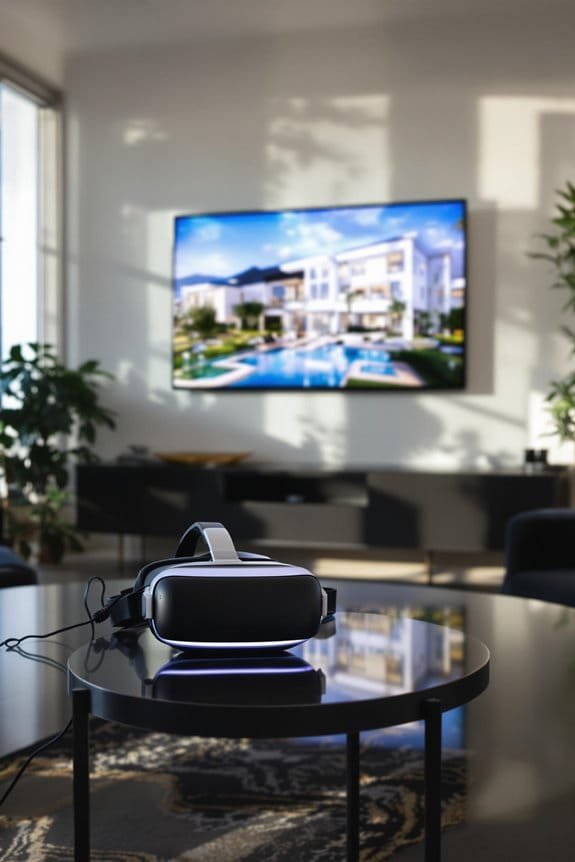By 2025, virtual reality will transform your experience of remote property tours, offering you a blend of accessibility and immersive realism that surpasses traditional methods. You’ll explore properties anytime, fostering a deeper emotional connection as you virtually walk through lifelike rooms and layouts. This technology not only broadens potential buyer reach globally but also helps you make informed decisions before arranging actual visits. Industry norms will evolve with advanced 3D renderings, AI-driven interactive features, and drone footage, enriching your engagement with properties. While challenges like initial costs and technical issues persist, advancements will continuously enhance the virtual touring experience. Discover what’s next.
Key Takeaways
- Virtual reality tours allow 24/7 access to properties, enabling buyers to explore at their convenience.
- AI integration in VR tours personalizes experiences, offering tailored interactive features for prospective buyers.
- Advanced 3D renderings and virtual staging enhance visualization, making properties more appealing and realistic.
- Remote property assessments via VR reduce the need for physical visits, streamlining the buying process.
- Overcoming technical challenges and accessibility issues will expand VR’s reach in real estate by 2025.
Key Benefits of VR Tours
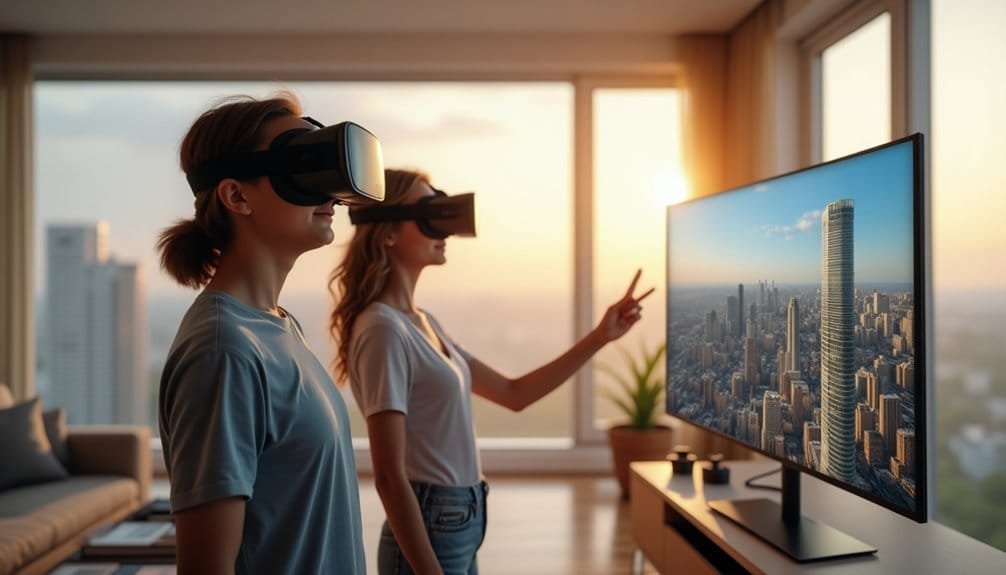
When it comes to exploring real estate, virtual reality tours offer a revolutionary way to enhance the client experience. They create a memorable journey, more impactful than static images, boosting the chances of clients revisiting your property website.
With 360-degree views and interactive elements, you can visualize living in a space, personalizing it with features like customizable wall colors and furniture placements. The convenience of accessing these tours 24/7 allows you to explore properties at your own pace.
This full immersion fosters a stronger emotional connection compared to traditional 2D images, making the experience personal and engaging. Virtual reality tours not only save time by reducing physical showings but also attract a global audience, maximizing exposure. By providing detailed insights into property layouts and designs, virtual tours help buyers make more informed decisions before even setting foot in the property. This approach allows realtors to manage a larger client base efficiently, as they can facilitate more inquiries simultaneously without the need for physical visits.
Current Industry Trends
As virtual reality continues to reshape the real estate landscape, staying abreast of current industry trends is essential.
The VR market is thriving, projected to hit USD 59.9 billion by 2033, showcasing a robust annual growth rate of 21%. Standardized virtual tours and 360-degree imagery are now industry norms. With North America leading the market share, the growth is driven by increased demand for unique travel experiences and advancements in VR technology. These tools, integrated with AI, personalize tours and automate planning, enhancing the buying experience. Demand remains high; 90% of buyers prefer listings with virtual tours, and these listings receive 87% more views. Virtual tours offer an immersive online experience that surpasses traditional photos, allowing potential buyers to explore properties in detail without having to be physically present.
Technological advancements, such as AI-driven insights and AR integration, offer detailed, immersive experiences. Agents can conduct collaborative virtual tours, guiding multiple clients through properties remotely.
This fusion of technology and real estate is transforming how we explore homes.
Effective Tour Techniques
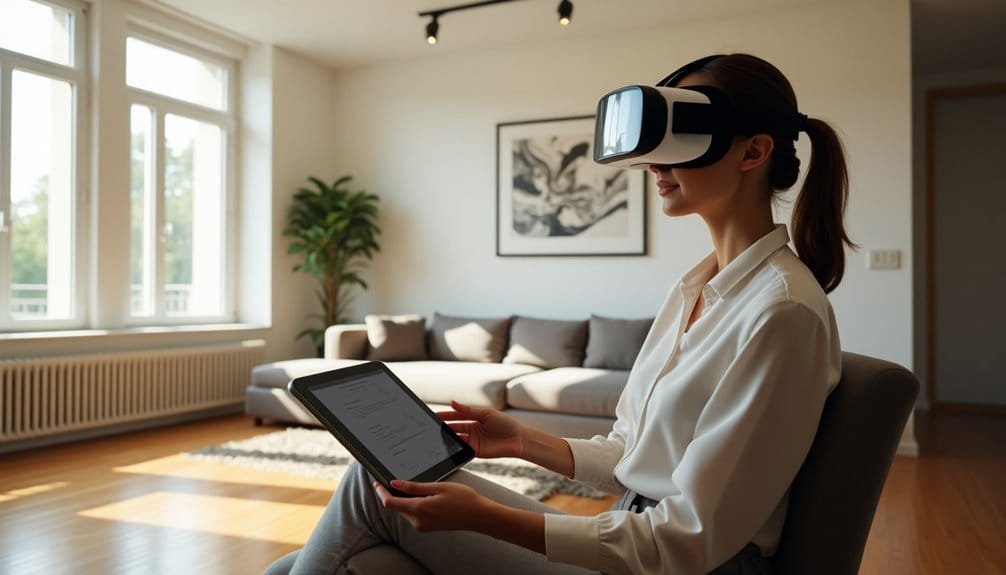
To create an engaging virtual property tour, it’s essential to master effective tour techniques. Start by planning a logical route that mirrors a buyer’s path through the home. List every room and open doors to showcase the property’s flow. Use both selfie stick and monopod methods for capturing 360-degree footage, ensuring proper monopod positioning to avoid distortion. Lighting plays a critical role, so emphasize creating a welcoming atmosphere. Center your camera, but test alternative spots in asymmetrical rooms. Enhance tours with hotspots and annotations to highlight key features, and integrate interactive elements like virtual open houses. With virtual staging, you can furnish spaces, allowing potential buyers to envision their future home. Realistic 3D renderings and interactive customization improve decision-making and reduce stress by providing detailed inspections of the property. Additionally, consider using drone aerial videos to showcase the property’s surroundings and provide an immersive experience that can engage potential buyers more effectively. These techniques can considerably boost engagement and accelerate property sales.
Future Predictions
After mastering effective tour techniques, you might wonder what’s next for virtual reality in real estate. By 2025, VR’s market value will soar to $2.6 billion, with AR and VR in real estate reaching $80 billion. Expect virtual tours to become industry standards as 90% of buyers prefer listings with them. AI and machine learning will personalize experiences, offering immersive tours with haptic feedback and interactive floor plans. Properties will feature virtual staging and realistic 3D renderings for enhanced visualization. The global VR market value in real estate is projected to reach $2.6 billion by 2025, highlighting the significant role of technology in transforming the real estate industry. VR enables immersive 3D tours of properties from home, which facilitates assessment for out-of-state or international buyers. Additionally, AI-driven investment predictions will further enhance the strategic marketing of properties by identifying potential buyers based on their preferences and behaviors.
| Feature | Impact |
|---|---|
| AI Integration | Personalized and interactive tours |
| Immersive Experiences | Haptic feedback for virtual textures |
| Virtual Staging | Furnishing to appeal to buyer preferences |
| Advanced Visualization | View properties under construction or renovation |
These advancements are set to revolutionize property sales and engagement.
Overcoming Challenges
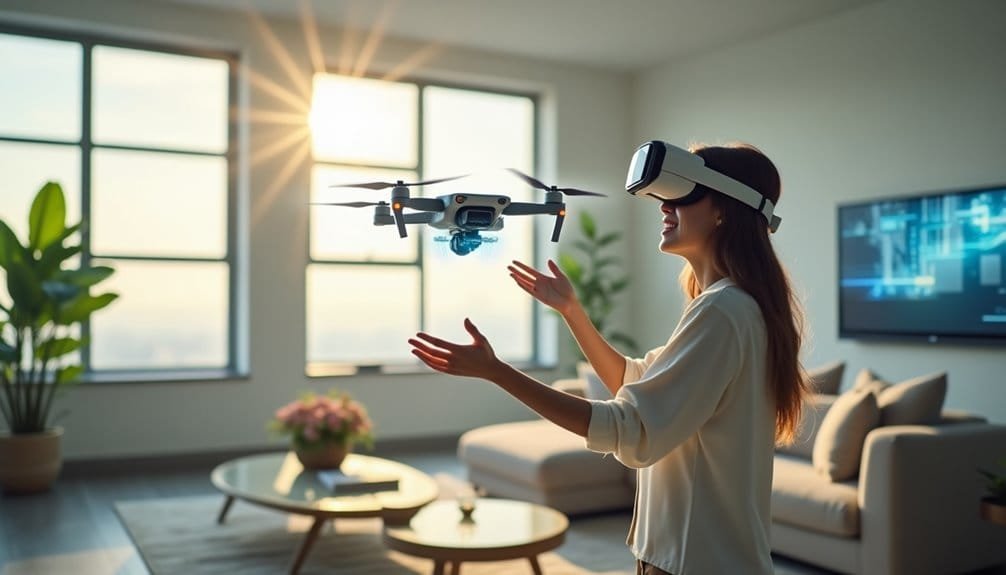
Although virtual reality has the potential to transform the real estate landscape, overcoming its challenges is essential for widespread adoption. High initial costs, including 3D cameras and VR equipment, pose significant barriers for smaller agencies. Additionally, the lack of VR headset accessibility in low-income areas limits reach. Technical issues like laggy visuals and device incompatibility can frustrate users, making VR seem more like a gimmick than a game-changer. Ensuring seamless experiences demands continuous technological investments. On the consumer side, not everyone is comfortable with new technology, necessitating guidance and training. Privacy and data safety concerns further complicate adoption. In some markets, virtual tours may enhance listing quality and attract more views, especially in less desirable neighborhoods where traditional methods fall short. With properties using VR showings commanding selling prices 7.25% higher than benchmarks, the potential financial benefits of VR can outweigh the initial costs for sellers. Finally, integrating VR tours into existing workflows and balancing them with in-person visits requires careful planning and management.
Upcoming Technological Advancements
As we look toward the future, the integration of cutting-edge technology promises to elevate the real estate industry, particularly through advancements in virtual reality (VR) and artificial intelligence (AI).
With AI, you can expect a more personalized experience as virtual tours adapt to your preferences. Imagine AI analyzing market trends, providing real-time insights, and even offering tailored property recommendations.
VR will enhance your experience with immersive 360-degree views, letting you explore properties in stunning detail. Augmented reality (AR) innovations will further enrich tours by allowing you to visualize renovations.
Consider these upcoming technological advancements:
- AI-driven insights for real-time property analysis.
- Immersive VR for detailed virtual home tours.
- AR integration to visualize potential changes.
- Predictive analytics to refine your property search.
- Enhanced 3D imaging for realistic property views.
Enhancing Buyer Experience
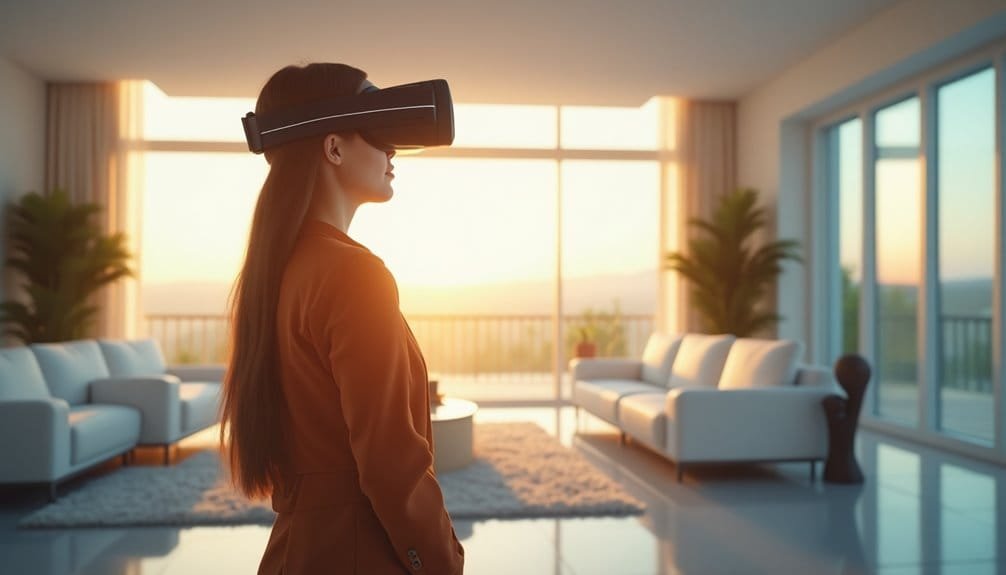
When it comes to buying a property, virtual reality revolutionizes how you experience the process. Imagine exploring every corner with 360-degree views, making it easier to envision yourself living there. You get a multi-sensory experience, allowing you to walk through rooms and understand the layout and flow.
Spending more time virtually exploring properties helps you form a deeper emotional connection, enhancing your interest. Virtual tours also streamline decision-making, providing detailed inspections and reducing uncertainty. They enable remote inspections, letting you assess properties from anywhere, and even collaborate with inspectors and sellers in virtual spaces.
This immersive experience not only expands market reach, but also makes the buying process more efficient by reducing unnecessary physical showings and focusing on serious buyers.
- Prepare for Loan Maturities and Refinancing Waves as a Real Estate AgentIn mastering loan maturities and refinancing waves, uncover strategies every real estate agent needs to empower clients during pivotal financial transitions.
Frequently Asked Questions
How Can Buyers Access Virtual Reality Home Tours Remotely?
You can access virtual reality home tours remotely through several methods.
Real estate websites often integrate virtual tours, letting you explore properties with just a click.
Using VR headsets offers a more immersive experience, simulating actual visits.
Video conferencing platforms provide guided tours for real-time interaction.
Smartphones and tablets allow access on-the-go, while dedicated VR apps enhance the experience.
These tools offer flexibility, convenience, and a thorough property view from anywhere.
Recent Posts

How to Pass the Real Estate Licensing Exam on the First Try

How to Get More Referrals From Past Clients (Even If You’re New)

How to Build a Personal Brand as a Real Estate Agent
What Equipment Is Needed to Experience a VR Home Tour?
To experience a VR home tour, you’ll need high-resolution 3D imaging from 360-degree cameras and specialized software to stitch the images together.
Access these tours using internet-connected devices like smartphones, tablets, or PCs. Enhance the experience with VR headsets such as Oculus Rift or Samsung Gear VR, and use hand controllers for interaction.
Options range from low-end Google VR cardboard to high-end HoloLens, ensuring compatibility with mobile apps and websites.
Are There Any Safety Concerns With Using VR for Home Tours?
You might face several safety concerns when using VR for home tours.
Physical injuries, like dizziness or falls, can occur due to sensory conflicts. Prolonged use can lead to eye strain and headaches. Verify your space is free of tripping hazards and sharp corners to mitigate risks.
Additionally, there’s a risk of personal data exposure and cybersecurity threats, including hacking and data leaks, which require attention to privacy and security measures.
Can Virtual Reality Tours Be Conducted on Mobile Devices?
You can definitely conduct virtual reality tours on mobile devices.
Most modern smartphones and tablets support VR tours, allowing you to view properties anywhere, anytime.
By scanning QR codes, you can easily access these tours, making the process seamless and portable.
Interactive features work smoothly on mobile platforms, offering an engaging experience comparable to desktops.
This convenience guarantees you can explore property details in-depth, enhancing your real estate journey efficiently.
How Do Virtual Reality Tours Cater to International Buyers?
Virtual reality tours cater to international buyers by providing 24/7 access to properties, breaking down geographical barriers.
You can explore homes from anywhere, experiencing detailed, immersive tours that mimic in-person visits.
VR tours let you visualize personalized spaces, enhancing decision-making. They offer extensive information with interactive hotspots and descriptions.
This technology streamlines your buying process, allowing you to efficiently filter properties, ultimately saving time and reducing the need for physical travel.
Bottom Line
In 2025, you’ll find virtual reality transforming remote property tours beyond your wildest dreams, making them indispensable for homebuyers and realtors alike. By embracing the latest trends and techniques, you’ll navigate challenges and leverage technological advancements to create unforgettable experiences. As VR continues to evolve, it promises to revolutionize how properties are showcased, enhancing buyer engagement and satisfaction. With these tools at your fingertips, the real estate world will never be the same again.

